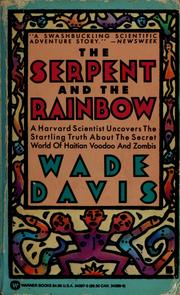“Against stupidity the gods themselves contend in vain.”— Friedrich Schiller
I hate trendy. Anything trendy is, by definition, part of pop culture – the zeitgeist of the mindless follower¹ – and makes me want to bob for hand grenades in a vat of sulfuric acid. I can’t stand anything about pop culture: pop art, pop music, pop television, pop psychology, pop fashion, popcorn, Pop Rocks, Pop-Tarts…Okay, I like Pop-Tarts. And popcorn is okay too, but the rest of that stuff sucks.
 Judging by this, you’d probably think that I hate vampires and zombies as well. These two beasties have dominated all aspects of the horror genre for years, primarily for two reasons, both of them bad. The first is that most horror writers don’t know anything about the supernatural, so they just copy what’s already popular. The second is that publishers and showbiz types, despite some of them claiming to be looking for projects that are new and different, are really only looking for more of the same. Take it from someone who’s played this game, if it’s not about vampires or zombies, they don’t want to hear it. I said ten years ago that I was going to upchuck the next time I saw a vampire book on the bestseller list. As you could probably guess, I’ve thrown up a lot since then.
Judging by this, you’d probably think that I hate vampires and zombies as well. These two beasties have dominated all aspects of the horror genre for years, primarily for two reasons, both of them bad. The first is that most horror writers don’t know anything about the supernatural, so they just copy what’s already popular. The second is that publishers and showbiz types, despite some of them claiming to be looking for projects that are new and different, are really only looking for more of the same. Take it from someone who’s played this game, if it’s not about vampires or zombies, they don’t want to hear it. I said ten years ago that I was going to upchuck the next time I saw a vampire book on the bestseller list. As you could probably guess, I’ve thrown up a lot since then.
Personally, I blame Anne Rice, Alex Garland and Danny Boyle, the author of The Vampire Chronicles and the writer and director of the film 28 Days Later respectively. I mostly blame them because it’s all their fault, but I bear them no ill will. Both works are solid contributions to the genre, and they had no way of knowing what they were unleashing on the world. You can’t hold Anne Rice responsible for Twilight.
So anyway, the answer is yes, I absolutely do hate anything related to vampires, but not so much zombies. The main reason is probably that, when I was originally trying to get my own horror novel published, vampires were all the rage and just about the only thing that publishers cared about, but the zombie craze hadn’t really taken hold just yet. Therefore, I don’t feel that I’ve been made to suffer unfairly at the hands of the zombies. Also, my brother is a huge zombie fan. Two years ago, he bought the whole family zombie insurance for Christmas. I’ve since let my policy lapse, but I’m sure that his is up to date. Another reason that I’m probably not as hard on the whole zombie thing is that 28 Days Later was essentially a low budget indie project, most likely because none of the big movie studios were interested in it because it wasn’t about vampires. The zombies have had to go toe to toe with the bloodsuckers themselves, and so far they’ve at least held their own.
Zombies have their origin in the folklore of Haiti, which isn’t surprising since that’s probably the only country in the world where they actually exist. No one outside of Haiti really took zombies seriously until Harvard ethnobotanist Wade Davis traveled there in 1982 and learned of a man named Clairvius Narcisse. Narcisse had been pronounced dead at an American run hospital two years earlier and had been buried but was nevertheless later discovered walking around in reasonably good health. Davis began researching the whole zombie thing and published his controversial findings in the Journal of Ethnopharmacology in 1983 and later wrote a book about his adventures in the real Zombieland called The Serpent and the Rainbow. It turns out that Narcisse had been completely paralyzed and unable to speak while at the hospital, but he had heard himself being pronounced dead and remembered being buried. He was later dug up by a bokor (a Haitian sorcerer) and informed that he was now a zombie under the bokor’s control. He had been used as a slave laborer on a farm for the previous two years before he was rescued.
 Davis’ research led him to conclude that the process of turning someone into a zombie was accomplished using two different sorts of drugs: tetrodotoxin, the highly lethal neurotoxin found in puffer fish; and datura, an extremely potent hallucinogenic plant which can also be fatal in high doses. Using powders made from these two substances (and some fairly grisly additional ingredients), the bokor is able to induce a death-like coma in the victim using the tetrodotoxin, which completely paralyzes them and slows their breathing and heart rate to a barely perceptible level, while the datura leaves them in a disoriented and highly suggestible state. The combination of these two drugs, along with the widespread belief in zombies among Haitians, leads the victim to believe that they have actually died and been raised from the dead by the bokor, whose control they are then under. Some suspect that a form of hypnosis may also play a role in all of this as a means of maintaining control once the drugs have worn off. Some academic types, most of whom have never been to Haiti, reject Davis’ findings, apparently because they just can’t believe that something like this could be real.
Davis’ research led him to conclude that the process of turning someone into a zombie was accomplished using two different sorts of drugs: tetrodotoxin, the highly lethal neurotoxin found in puffer fish; and datura, an extremely potent hallucinogenic plant which can also be fatal in high doses. Using powders made from these two substances (and some fairly grisly additional ingredients), the bokor is able to induce a death-like coma in the victim using the tetrodotoxin, which completely paralyzes them and slows their breathing and heart rate to a barely perceptible level, while the datura leaves them in a disoriented and highly suggestible state. The combination of these two drugs, along with the widespread belief in zombies among Haitians, leads the victim to believe that they have actually died and been raised from the dead by the bokor, whose control they are then under. Some suspect that a form of hypnosis may also play a role in all of this as a means of maintaining control once the drugs have worn off. Some academic types, most of whom have never been to Haiti, reject Davis’ findings, apparently because they just can’t believe that something like this could be real.
While all of this may have been shocking and hard to believe for the rest of the world, it wasn’t news to the Haitian government. They passed a law way back in 1864 making the use of toxins to fake a person’s death illegal. Anyone caught trying this could be charged with attempted murder, but they didn’t stop there. Just to show that they weren’t screwing around, this law also states that if the victim is actually buried, then the individual who poisoned them will be charged with murder whether the person died or not. So one burial equals one homicide in these cases, even if the victim lives, which there’s a good chance they won’t. There’s no good way of knowing for sure, but it’s suspected that most attempts at creating a zombie result in the victim’s death, either because the tetrodotoxin kills them or they suffocate because they weren’t dug up in time. That would be a truly crappy way to go, especially because you would probably remember the whole thing just like Mr. Narcisse did.
Okay, that’s enough of boring old reality. Let’s get to the hypothetical, much less likely stuff.
While some of the more popular zombie franchises of recent years have stuck with the more traditional undead variety of ghoulies, others have portrayed them as having been turned into hordes of bloodthirsty psychos as the result of becoming infected by some type of virus, which could theoretically happen. So I’m going to be at least somewhat trendy now and take a look at the possibility, however remote, that something like this could really happen.
When most people think of a zombie virus, they probably imagine some ill-conceived biological weapon that was cooked up in a government laboratory somewhere that somehow got turned loose on society. In reality, there’s already a virus that meets most of the requirements for being able to unleash a zombie apocalypse on the planet, and it’s fairly common in some parts of the world. It’s the reason that it’s a red tape nightmare to transport most animals, even house pets, into Europe. If you have a dog or cat, you should know that the law says that they have to get a shot for it every once in a while despite the possible risk of inducing canine/feline autism. It is, of course, rabies.
Pretty much everything that zombies do in fiction, rabies infected animals do in real life. Basically, they lose their freakin’ minds and start trying to bite everything that moves. This is because rabies in predominantly transmitted through saliva, which is also why they foam at the mouth. An excess of saliva increases the likelihood of the disease being spread, and biting is obviously the most effective delivery system. Some strains of rabies also make it difficult and painful for the victim to swallow. The reason for this makes bone-chilling sense. If the infected creature can swallow, this means that there will be less saliva in their mouths to infect others. The virus “knows” that keeping its host from swallowing increases its odds of being passed on to others. Viruses are really good at working out how to spread themselves around, which is pretty impressive seeing as how they don’t have actual brains. (Any of this sound familiar to you World War Z aficionados?) Fortunately for us, rabies doesn’t seem to be the smartest kid on the viral block. It has some shortcomings that have mostly held it in check over the years without our having to do all that much to stop it. The two main things which have prevented rabies from bringing about a zombie holocaust are its method of transmission and its incubation time.
 It’s harder to bite living things that don’t want to get bitten than they make it look in the movies. I guess that’s why movie zombies can only be killed by shooting them in the head or decapitating them. In real life, being attacked by a rabid human wouldn’t be all that different from being attacked by a normal one, at least in theory. If some drooling psycho came after you in an alley, you could just bash him in the head with the closest heavy object you could find, call the police and that would be that. The almost complete inability to think rationally would probably mean that the guy wouldn’t even bother to duck. The bottom line is, regardless of what Hollywood tells us, having to have your host sink their teeth into someone just isn’t a very efficient way for a virus to have to spread itself around.
It’s harder to bite living things that don’t want to get bitten than they make it look in the movies. I guess that’s why movie zombies can only be killed by shooting them in the head or decapitating them. In real life, being attacked by a rabid human wouldn’t be all that different from being attacked by a normal one, at least in theory. If some drooling psycho came after you in an alley, you could just bash him in the head with the closest heavy object you could find, call the police and that would be that. The almost complete inability to think rationally would probably mean that the guy wouldn’t even bother to duck. The bottom line is, regardless of what Hollywood tells us, having to have your host sink their teeth into someone just isn’t a very efficient way for a virus to have to spread itself around.
If rabies were to mutate or somehow combine with another virus to make it an airborne contagion, then it would be a different story. Combining with the flu would probably be the worst case scenario. Influenza is highly contagious and, being airborne, is much easier to spread around. We still have massive flu outbreaks several times every century with hundreds of thousands or even millions getting sick. During the Spanish flu pandemic of 1918, an estimated 40 million people died, and hundreds of millions were infected. Imagine all of those people also having rabies, going nuts and actively trying to infect others with a strain of the disease that could be spread by just coughing in an elevator or sneezing on a crowded train.
Which brings us to factor number two. With almost all infectious diseases, including rabies, it takes at least a few days for symptoms to appear and the person to become contagious. Epidemiologists who are whimsical enough to humor us by talking about such things point out that even a day or two is plenty of time to identify and isolate individuals at risk for infection. Even if a strain of rabies became resistant to the vaccine, which isn’t that unlikely, victims could still be removed from the public before they posed any serious threat. For a real rabies-zombie apocalypse to happen, people would have to become infectious within a few hours. It wouldn’t have to be almost immediate like in the previously mentioned films, but it would still have to be a whole lot faster than it is. So until rabies finds a way to make it over these two hurdles, it can probably never be the global catastrophe that it dreams of someday becoming.²
If both of these things do somehow manage to happen, then we might be in trouble. I’m not sure how we would deal with it, but one thing that I am sure of is that the second that the zombie insurance companies get wind (pun partially intended) of an airborne zombie virus, they’ll be cancelling your policy for any piddly little reason they can think of. If you’re even a day late with your monthly premium, have visited Haiti in the last ten years, or have ever had unprotected sex with a rabies infected lunatic, good luck getting them to cough up one bloody dime for your daughter’s lifesaving total body blood transfusion or brain replacement surgery. You’ll regret not having signed up for that monthly auto-pay option when that happens, if not the rabies infected lunatic sex you had in Haiti back in college. It was Spring Break after all.
“But what about bovine spongiform encephalopathy?” you ask. To which I reply that people don’t get mad cow disease. In humans, it’s called variant Creutzfeldt–Jakob³ disease (vCJD). It is nasty stuff, and you definitely don’t want it, but a lot of the rumors about mad cow were the result of misinformation and people panicking. While it’s true that cows with BSE may become aggressive, it’s also true that it’s a hard disease to pass along to others. By far the easiest way to catch it is to eat the flesh of a cow with BSE or a human with vCJD. Neither form is a virus, but if they  were, they would have to be the Einsteins of the viral world in order to figure out a way to get uninfected people to eat infected ones. Making your host want to bite everybody is one thing; making others want to bite your host is something altogether different. My first thought was that it could make them taste like bacon, but then I remembered hearing somewhere that we already taste like pork, and yet most of us still somehow manage to refrain from engaging in cannibalism. So much for mad cow disease taking over the world.
were, they would have to be the Einsteins of the viral world in order to figure out a way to get uninfected people to eat infected ones. Making your host want to bite everybody is one thing; making others want to bite your host is something altogether different. My first thought was that it could make them taste like bacon, but then I remembered hearing somewhere that we already taste like pork, and yet most of us still somehow manage to refrain from engaging in cannibalism. So much for mad cow disease taking over the world.
Of course, the far more insidious scenario for a global zombie meltdown would be the widespread proliferation of the recently discovered stupidity virus, ATCV-1, which was the actual inspiration for this piece. (Now I’m being trendy and topical!) Researchers from Johns Hopkins School of Medicine and the University of Nebraska4 first discovered the virus in throat cultures taken from subjects while researching something completely unrelated. ATCV-1 is a virus that was thought to only infect certain kinds of freshwater algae, and they’re still not sure how it got into humans. What they do know is that when they performed tests on cognitive functioning, the 40 of their 92 subjects (43.5%) who had the virus had shorter attention spans, slower visual processing and visual motor speed, and decreased spatial awareness. Overall, their tests showed that ATCV-1 impaired memory and learning and that those infected had IQ scores seven to nine points below average. So around 44% of us already have this and more may be likely to catch it. That’s not good. And seven to nine lost IQ points is bad enough, but imagine if the virus manages to mutate into a more powerful strain capable of dropping intelligence levels by two or three times that. The average IQ is already an embarrassingly low 100, and anything less than 70 is considered severe mental impairment. There are already far too many people on this planet who are just scraping by with the limited brain capacity that they’ve got. If this thing ever becomes rampant and drops the average IQ to less than 80 in nearly half of the population, we’re all doomed.
 Those with a tendency to look for things to be offended by might think that I’m just writing about this to poke fun at the mentally impaired, but nothing could be further from the truth. I’m more serious about this than anything I’ve written on the subject thus far. If our population ever gets to a point where the number of people who need constant supervision exceeds the number of people available to supervise them, we are in deep trouble. The stupidity virus5 truly could be the one that brings our civilization to a crashing halt. In a way, it would be ironically appropriate if stupidity were to be our final downfall. I think that many of us have suspected all along that this would be the case, but probably not like this. I think most of us thought it would be the politicians who got us all killed.
Those with a tendency to look for things to be offended by might think that I’m just writing about this to poke fun at the mentally impaired, but nothing could be further from the truth. I’m more serious about this than anything I’ve written on the subject thus far. If our population ever gets to a point where the number of people who need constant supervision exceeds the number of people available to supervise them, we are in deep trouble. The stupidity virus5 truly could be the one that brings our civilization to a crashing halt. In a way, it would be ironically appropriate if stupidity were to be our final downfall. I think that many of us have suspected all along that this would be the case, but probably not like this. I think most of us thought it would be the politicians who got us all killed.
So there’s your zombie apocalypse update. As far as the vampires are concerned, they can all kiss my lily white ass. I spent three months in Transylvania a few years ago, and in all that time none of those bloodsucking pantywaists ever managed to so much as lay a single claw on me right there on their own home turf. Freakin’ pretty boy pansies.
________________________________________________________________________
¹Which is actually not a bad definition of a zombie.
²Even so, it does manage to take out around 50,000 or so people each year. That’s more than lightning strikes, shark attacks, snakebites and peanut allergies combined, but still far less than diseases like the much more destructive malaria, which kills an estimated one million people annually. Yes, mosquitos are more dangerous than sharks. Who’d of thunk it?
3Named for the 19th century Austrian actor Johann Creutzfeldt, who was mad, and early 20th century Norwegian socialite Marion Jakob, who was a cow.
4Now that’s an odd pairing.
5They do need to come up with a better name for this thing though. We really can’t expect doctors to tell their patients “I’m sorry Mr. Harrison, but you have stupidity.”


